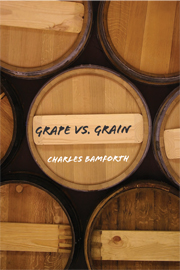Book contents
- Frontmatter
- Contents
- Preface
- Grape vs. Grain
- 1 Beer and Wine: Some Social Commentary
- 2 A Brief History of Wine
- 3 A Brief History of Beer
- 4 How Wine Is Made
- 5 How Beer Is Made
- 6 The Quality of Wine
- 7 The Quality of Beer
- 8 Types of Wine
- 9 Types of Beer
- 10 The Healthfulness of Wine and Beer
- 11 Conclusions about Beer and Wine – and the Future
- Further Reading
- Index
9 - Types of Beer
Published online by Cambridge University Press: 16 September 2009
- Frontmatter
- Contents
- Preface
- Grape vs. Grain
- 1 Beer and Wine: Some Social Commentary
- 2 A Brief History of Wine
- 3 A Brief History of Beer
- 4 How Wine Is Made
- 5 How Beer Is Made
- 6 The Quality of Wine
- 7 The Quality of Beer
- 8 Types of Wine
- 9 Types of Beer
- 10 The Healthfulness of Wine and Beer
- 11 Conclusions about Beer and Wine – and the Future
- Further Reading
- Index
Summary
There is no reason why brewers couldn't play on the strengths of grain or hop variety in the styling of their products. At present, it is fairly tangential – for instance, a brewer may boast about his or her use of hops with a certain provenance, perhaps Tettnang or Hersbrucker in Germanic lagers or Fuggles in English ales. Surely, this could be done much more: The characters unique to an aroma hop are no less special or unique than those associated with a given grape varietal. So where a winemaker may compare Pinot Noirs, Chardonnays, and Zinfandels produced by different vintners, so could the brewers, with no less sophistication or passion, debate the merits of different beers using Saaz or Challenger or Cascade.
The fact is they don't. Rather, brewers rejoice in styles that are founded on the type of grain, the extent to which the wort is fermentable, the strength, the color, and the brewing technique.
As a first fundamental, we speak of ales and lagers. The former have the more ancient pedigree. Once upon a time, the word “ale” was used to describe unhopped products. These days, virtually all ales are hopped. A classic feature of an ale is that it is fermented using a “top fermenting yeast,” that is, a yeast that rises to the top of the vessel during fermentation. Fermentation is effected at a relatively warm temperature, say, 16°C (61°F), which leads to relatively high levels of esters (fruity flavors).
- Type
- Chapter
- Information
- Grape vs. GrainA Historical, Technological, and Social Comparison of Wine and Beer, pp. 141 - 162Publisher: Cambridge University PressPrint publication year: 2008



